Abstract
The ability of a fetus to heal without scar formation depends on its gestational age at the time of injury and the size of the wound defect. In general, linear incisions heal without scar until late in gestation whereas excisional wounds heal with scar at an earlier gestational age. The profiles of fetal proteoglycans, collagens, and growth factors are different from those in adult wounds. The less-differentiated state of fetal skin is probably an important characteristic responsible for scarless repair. There is minimal inflammation in fetal wounds. Fetal wounds are characterized by high levels of hyaluronic acid and its stimulator(s) with more rapid, highly organized collagen deposition. The roles of peptide growth factors such as transforming growth factor-beta and basic fibroblast growth factor are less prominent in fetal than in adult wound healing. Platelet-derived growth factor has been detected in scarless fetal skin wounds, but its role is unknown. An understanding of scarless tissue repair has possible clinical application in the modulation of adult fibrotic diseases and abnormal scar-forming conditions.
Full text
PDF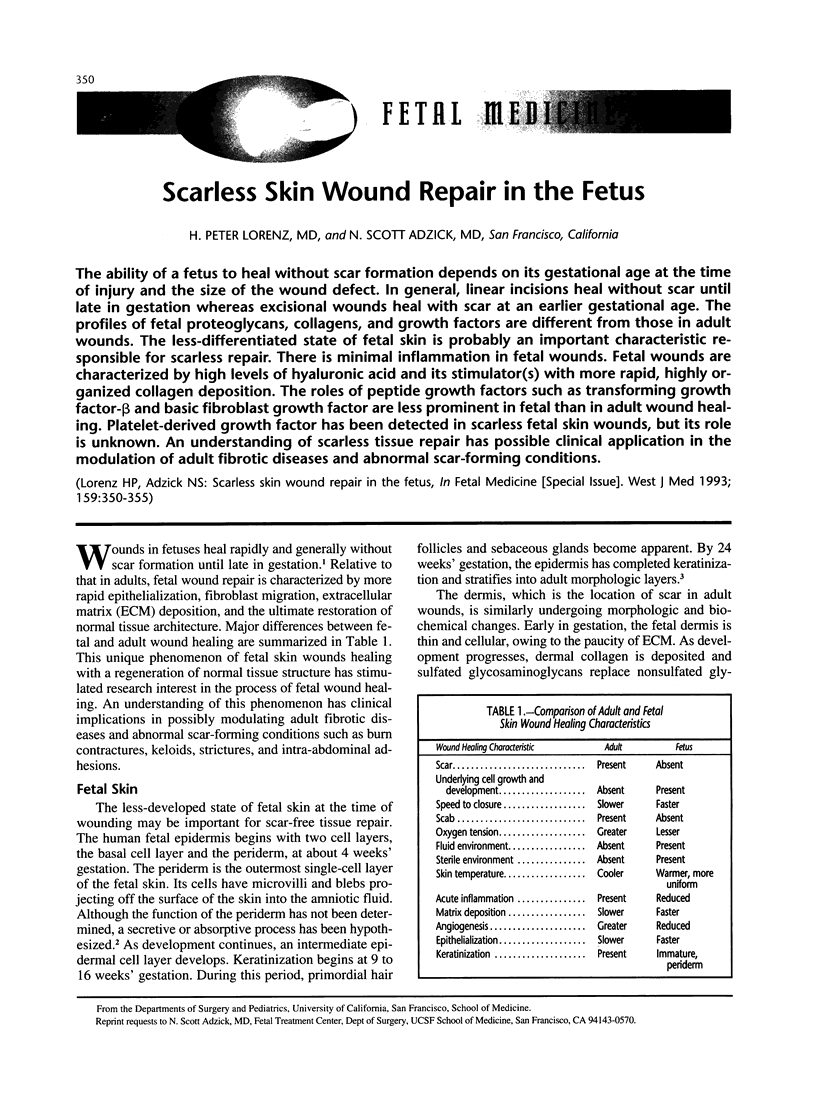
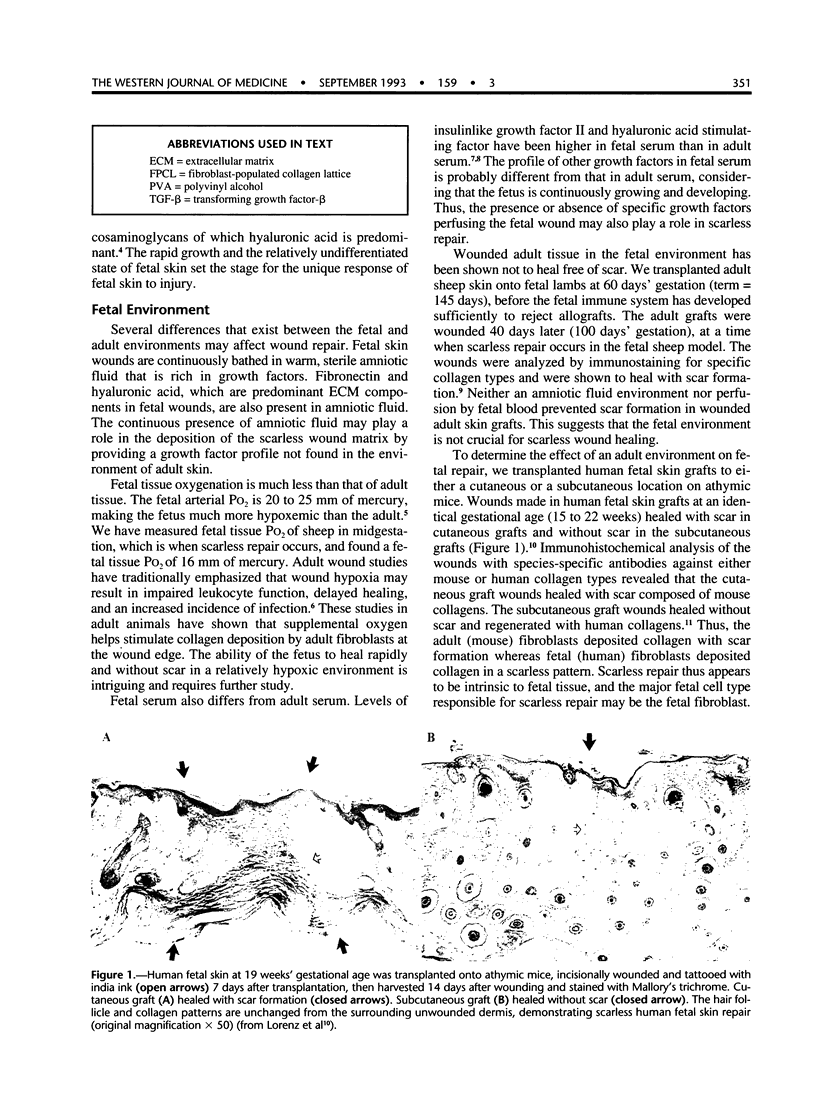
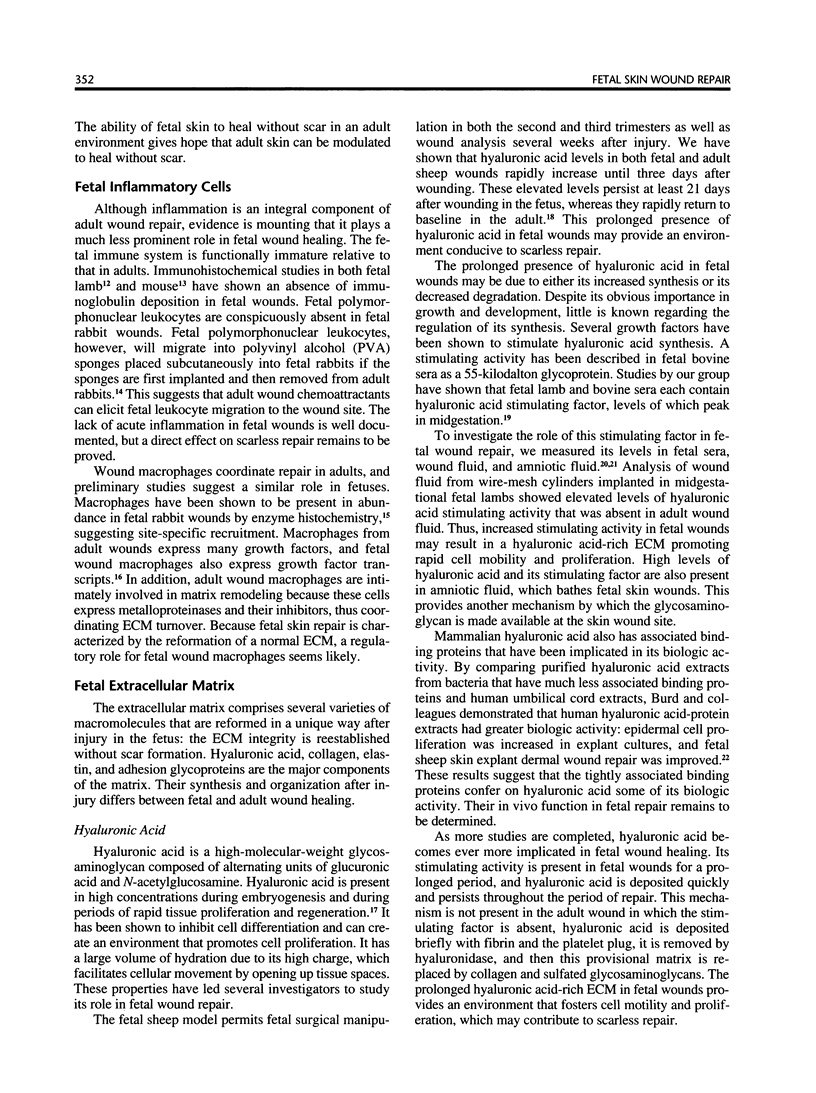
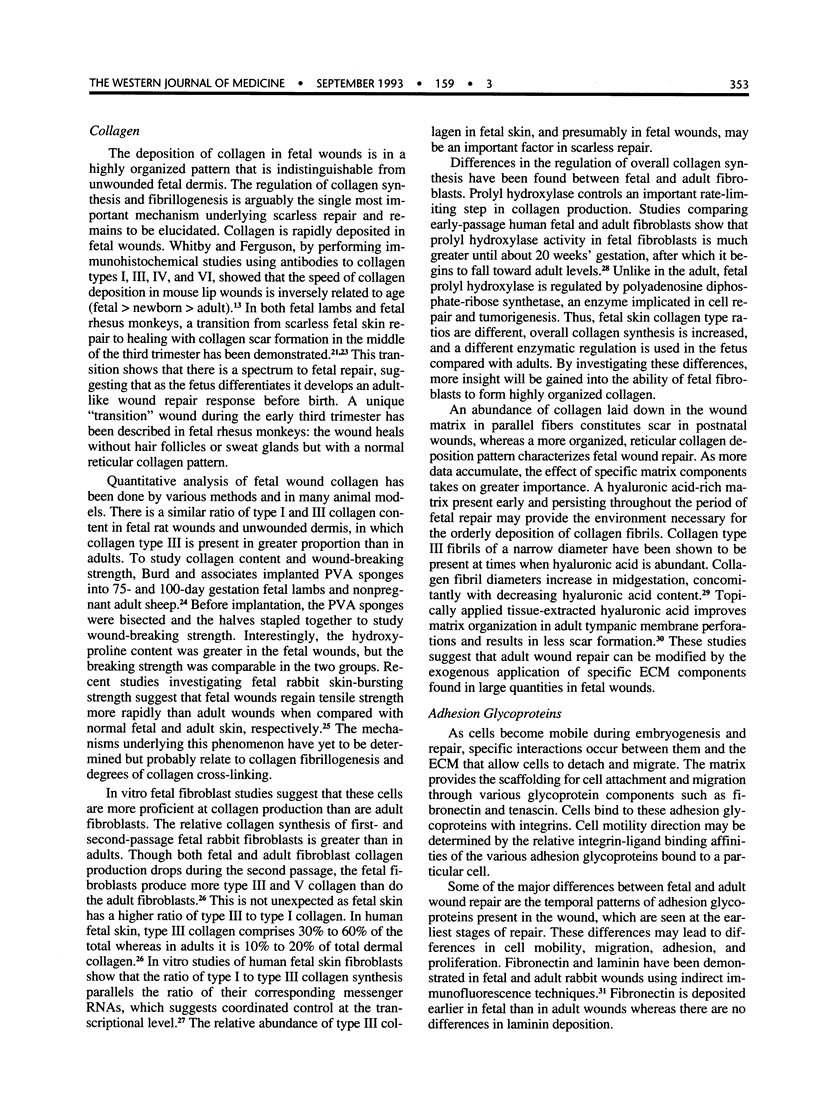
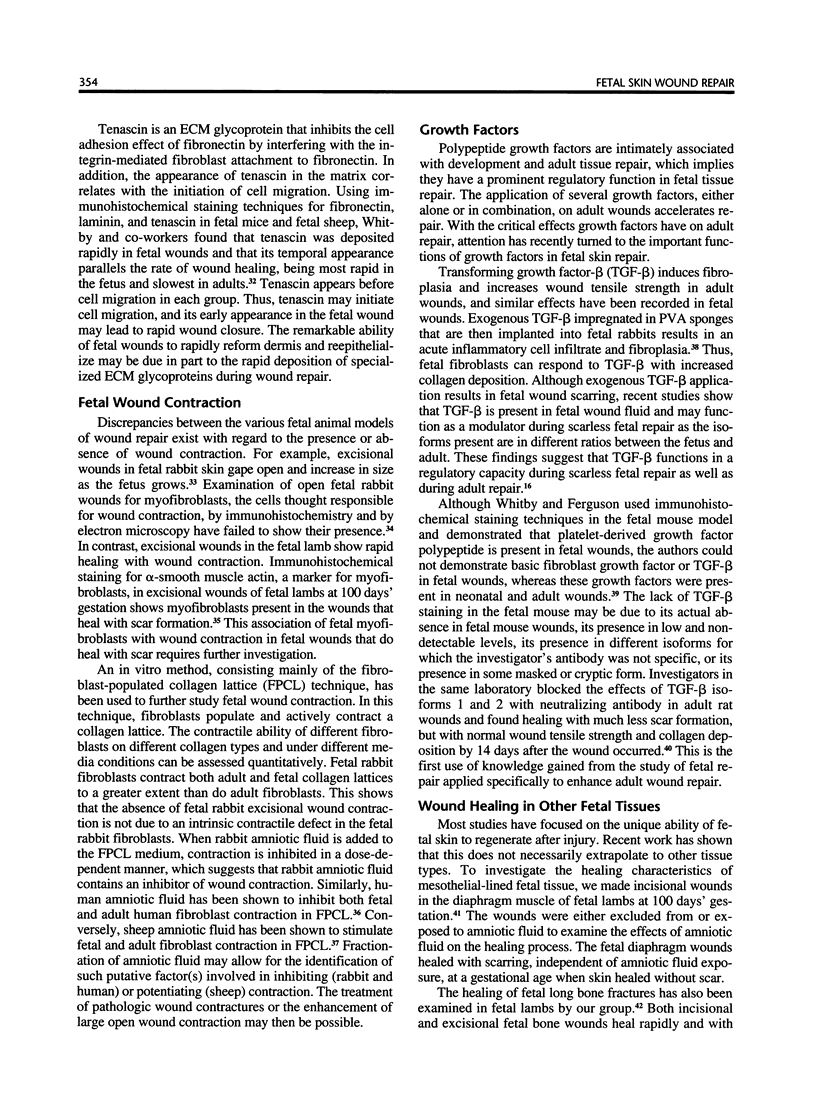
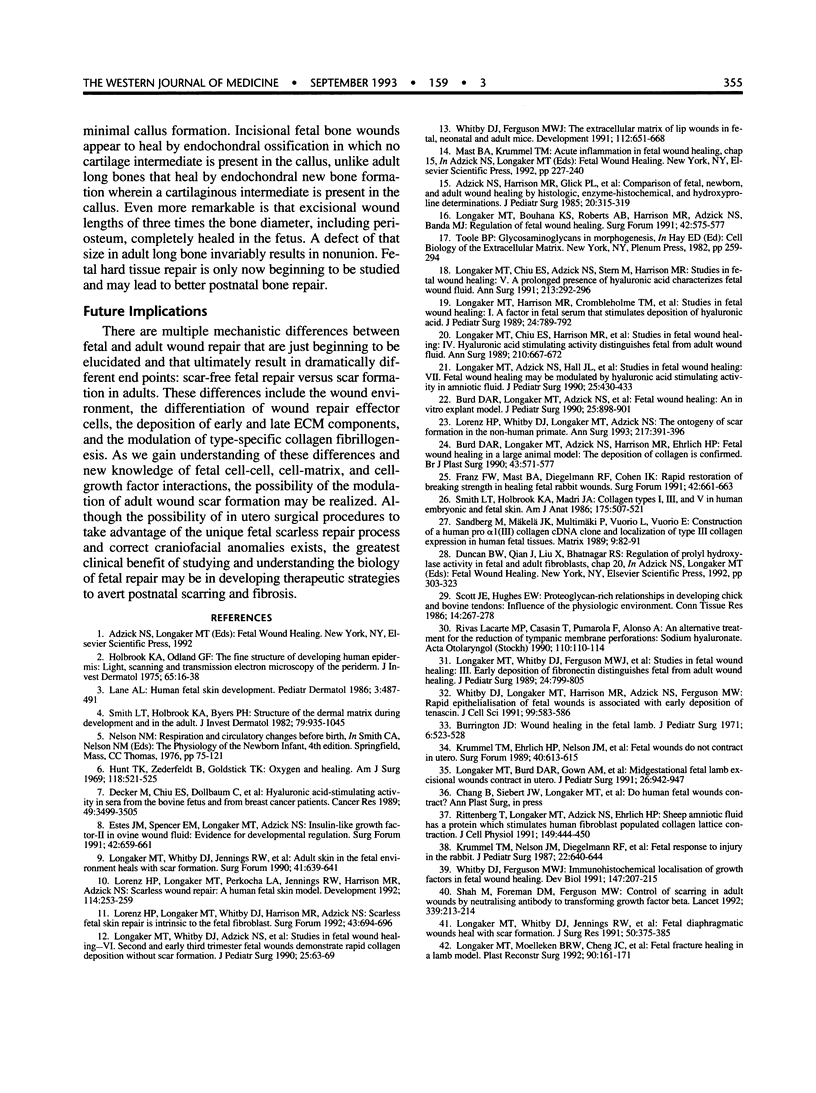
Images in this article
Selected References
These references are in PubMed. This may not be the complete list of references from this article.
- Adzick N. S., Harrison M. R., Glick P. L., Beckstead J. H., Villa R. L., Scheuenstuhl H., Goodson W. H., 3rd Comparison of fetal, newborn, and adult wound healing by histologic, enzyme-histochemical, and hydroxyproline determinations. J Pediatr Surg. 1985 Aug;20(4):315–319. doi: 10.1016/s0022-3468(85)80210-4. [DOI] [PubMed] [Google Scholar]
- Burd D. A., Longaker M. T., Adzick N. S., Compton C. C., Harrison M. R., Siebert J. W., Ehrlich H. P. Fetal wound healing: an in vitro explant model. J Pediatr Surg. 1990 Aug;25(8):898–901. doi: 10.1016/0022-3468(90)90199-j. [DOI] [PubMed] [Google Scholar]
- Burd D. A., Longaker M. T., Adzick N. S., Harrison M. R., Ehrlich H. P. Foetal wound healing in a large animal model: the deposition of collagen is confirmed. Br J Plast Surg. 1990 Sep;43(5):571–577. doi: 10.1016/0007-1226(90)90122-g. [DOI] [PubMed] [Google Scholar]
- Burrington J. D. Wound healing in the fetal lamb. J Pediatr Surg. 1971 Oct;6(5):523–528. doi: 10.1016/0022-3468(71)90373-3. [DOI] [PubMed] [Google Scholar]
- Decker M., Chiu E. S., Dollbaum C., Moiin A., Hall J., Spendlove R., Longaker M. T., Stern R. Hyaluronic acid-stimulating activity in sera from the bovine fetus and from breast cancer patients. Cancer Res. 1989 Jul 1;49(13):3499–3505. [PubMed] [Google Scholar]
- Holbrook K. A., Odland G. F. The fine structure of developing human epidermis: light, scanning, and transmission electron microscopy of the periderm. J Invest Dermatol. 1975 Jul;65(1):16–38. doi: 10.1111/1523-1747.ep12598029. [DOI] [PubMed] [Google Scholar]
- Hunt T. K., Zederfeldt B., Goldstick T. K. Oxygen and healing. Am J Surg. 1969 Oct;118(4):521–525. doi: 10.1016/0002-9610(69)90174-3. [DOI] [PubMed] [Google Scholar]
- Krummel T. M., Nelson J. M., Diegelmann R. F., Lindblad W. J., Salzberg A. M., Greenfield L. J., Cohen I. K. Fetal response to injury in the rabbit. J Pediatr Surg. 1987 Jul;22(7):640–644. doi: 10.1016/s0022-3468(87)80117-3. [DOI] [PubMed] [Google Scholar]
- Lane A. T. Human fetal skin development. Pediatr Dermatol. 1986 Dec;3(6):487–491. doi: 10.1111/j.1525-1470.1986.tb00656.x. [DOI] [PubMed] [Google Scholar]
- Longaker M. T., Adzick N. S., Hall J. L., Stair S. E., Crombleholme T. M., Duncan B. W., Bradley S. M., Harrison M. R., Stern R. Studies in fetal wound healing, VII. Fetal wound healing may be modulated by hyaluronic acid stimulating activity in amniotic fluid. J Pediatr Surg. 1990 Apr;25(4):430–433. doi: 10.1016/0022-3468(90)90387-o. [DOI] [PubMed] [Google Scholar]
- Longaker M. T., Burd D. A., Gown A. M., Yen T. S., Jennings R. W., Duncan B. W., Harrison M. R., Adzick N. S. Midgestational excisional fetal lamb wounds contract in utero. J Pediatr Surg. 1991 Aug;26(8):942–948. doi: 10.1016/0022-3468(91)90841-g. [DOI] [PubMed] [Google Scholar]
- Longaker M. T., Chiu E. S., Adzick N. S., Stern M., Harrison M. R., Stern R. Studies in fetal wound healing. V. A prolonged presence of hyaluronic acid characterizes fetal wound fluid. Ann Surg. 1991 Apr;213(4):292–296. doi: 10.1097/00000658-199104000-00003. [DOI] [PMC free article] [PubMed] [Google Scholar]
- Longaker M. T., Chiu E. S., Harrison M. R., Crombleholme T. M., Langer J. C., Duncan B. W., Adzick N. S., Verrier E. D., Stern R. Studies in fetal wound healing. IV. Hyaluronic acid-stimulating activity distinguishes fetal wound fluid from adult wound fluid. Ann Surg. 1989 Nov;210(5):667–672. doi: 10.1097/00000658-198911000-00016. [DOI] [PMC free article] [PubMed] [Google Scholar]
- Longaker M. T., Harrison M. R., Crombleholme T. M., Langer J. C., Decker M., Verrier E. D., Spendlove R., Stern R. Studies in fetal wound healing: I. A factor in fetal serum that stimulates deposition of hyaluronic acid. J Pediatr Surg. 1989 Aug;24(8):789–792. doi: 10.1016/s0022-3468(89)80538-x. [DOI] [PubMed] [Google Scholar]
- Longaker M. T., Moelleken B. R., Cheng J. C., Jennings R. W., Adzick N. S., Mintorovich J., Levinsohn D. G., Gordon L., Harrison M. R., Simmons D. J. Fetal fracture healing in a lamb model. Plast Reconstr Surg. 1992 Aug;90(2):161–173. [PubMed] [Google Scholar]
- Longaker M. T., Whitby D. J., Adzick N. S., Crombleholme T. M., Langer J. C., Duncan B. W., Bradley S. M., Stern R., Ferguson M. W., Harrison M. R. Studies in fetal wound healing, VI. Second and early third trimester fetal wounds demonstrate rapid collagen deposition without scar formation. J Pediatr Surg. 1990 Jan;25(1):63–69. doi: 10.1016/s0022-3468(05)80165-4. [DOI] [PubMed] [Google Scholar]
- Longaker M. T., Whitby D. J., Ferguson M. W., Harrison M. R., Crombleholme T. M., Langer J. C., Cochrum K. C., Verrier E. D., Stern R. Studies in fetal wound healing: III. Early deposition of fibronectin distinguishes fetal from adult wound healing. J Pediatr Surg. 1989 Aug;24(8):799–805. doi: 10.1016/s0022-3468(89)80540-8. [DOI] [PubMed] [Google Scholar]
- Longaker M. T., Whitby D. J., Jennings R. W., Duncan B. W., Ferguson M. W., Harrison M. R., Adzick N. S. Fetal diaphragmatic wounds heal with scar formation. J Surg Res. 1991 Apr;50(4):375–385. doi: 10.1016/0022-4804(91)90206-2. [DOI] [PubMed] [Google Scholar]
- Lorenz H. P., Longaker M. T., Perkocha L. A., Jennings R. W., Harrison M. R., Adzick N. S. Scarless wound repair: a human fetal skin model. Development. 1992 Jan;114(1):253–259. doi: 10.1242/dev.114.1.253. [DOI] [PubMed] [Google Scholar]
- Lorenz H. P., Whitby D. J., Longaker M. T., Adzick N. S. Fetal wound healing. The ontogeny of scar formation in the non-human primate. Ann Surg. 1993 Apr;217(4):391–396. doi: 10.1097/00000658-199304000-00011. [DOI] [PMC free article] [PubMed] [Google Scholar]
- Rittenberg T., Longaker M. T., Adzick N. S., Ehrlich H. P. Sheep amniotic fluid has a protein factor which stimulates human fibroblast populated collagen lattice contraction. J Cell Physiol. 1991 Dec;149(3):444–450. doi: 10.1002/jcp.1041490313. [DOI] [PubMed] [Google Scholar]
- Rivas Lacarte M. P., Casasin T., Pumarola F., Alonso A. An alternative treatment for the reduction of tympanic membrane perforations: sodium hyaluronate. A double blind study. Acta Otolaryngol. 1990 Jul-Aug;110(1-2):110–114. doi: 10.3109/00016489009122523. [DOI] [PubMed] [Google Scholar]
- Sandberg M., Mäkelä J. K., Multimäki P., Vuorio T., Vuorio E. Construction of a human pro alpha 1(III) collagen cDNA clone and localization of type III collagen expression in human fetal tissues. Matrix. 1989 Mar;9(2):82–91. doi: 10.1016/s0934-8832(89)80025-3. [DOI] [PubMed] [Google Scholar]
- Scott J. E., Hughes E. W. Proteoglycan-collagen relationships in developing chick and bovine tendons. Influence of the physiological environment. Connect Tissue Res. 1986;14(4):267–278. doi: 10.3109/03008208609017470. [DOI] [PubMed] [Google Scholar]
- Shah M., Foreman D. M., Ferguson M. W. Control of scarring in adult wounds by neutralising antibody to transforming growth factor beta. Lancet. 1992 Jan 25;339(8787):213–214. doi: 10.1016/0140-6736(92)90009-r. [DOI] [PubMed] [Google Scholar]
- Smith L. T., Holbrook K. A., Madri J. A. Collagen types I, III, and V in human embryonic and fetal skin. Am J Anat. 1986 Apr;175(4):507–521. doi: 10.1002/aja.1001750409. [DOI] [PubMed] [Google Scholar]
- Whitby D. J., Ferguson M. W. Immunohistochemical localization of growth factors in fetal wound healing. Dev Biol. 1991 Sep;147(1):207–215. doi: 10.1016/s0012-1606(05)80018-1. [DOI] [PubMed] [Google Scholar]
- Whitby D. J., Ferguson M. W. The extracellular matrix of lip wounds in fetal, neonatal and adult mice. Development. 1991 Jun;112(2):651–668. doi: 10.1242/dev.112.2.651. [DOI] [PubMed] [Google Scholar]
- Whitby D. J., Longaker M. T., Harrison M. R., Adzick N. S., Ferguson M. W. Rapid epithelialisation of fetal wounds is associated with the early deposition of tenascin. J Cell Sci. 1991 Jul;99(Pt 3):583–586. doi: 10.1242/jcs.99.3.583. [DOI] [PubMed] [Google Scholar]




